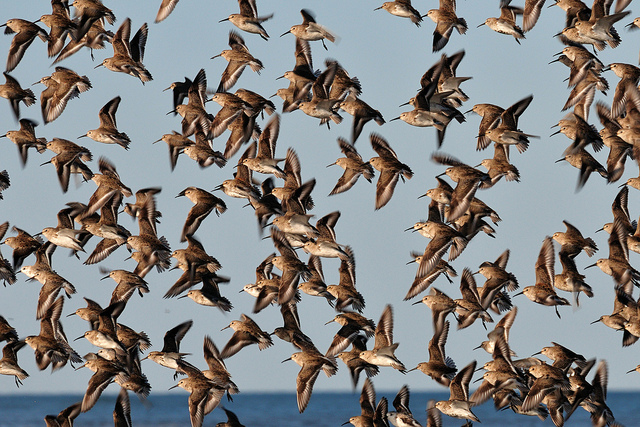
The dunlin (Calidris alpina) is a small shorebird about seven or eight inches long, with a graceful downcurved bill. When breeding, its plumage is a study of delicate russet over an oil-black breast and belly. The rest of the year it is a drab gray, like it has rolled in ash. As such, when dunlin gather during the winter months on the sloughs around Padilla Bay, in northern Washington, the flocks can look from a distance like an undifferentiated gray smear.
I am staring through my binoculars at just such a smear, tasked this cold January morning with counting dunlin on a crescent of shore. The standard method is to start at the flock’s front and work back from there, batching the birds in groups of increasing quantity, like so:
1-2-3-4-5-6-7-8-9-10…20…30…40…50…..100……200……300……400……500……600……700……800……900
Things go smoothly until somewhere between nine hundred and a thousand, when the flock starts to stir. The effect is subtle at first, as single birds take off and move from back to front, perhaps so they don’t have to forage in mud their flock-mates have picked clean. But then more dunlin follow, and before long the entire flock is rolling over itself as if on a great conveyer. Since I don’t want to double-count birds, I start again.
1-2-3-4-5-6-7-8-9-10…20…30…40…50…..100……200……300……400 Shoot!
1-2-3-4-5-6-7-8-9-10…20…30…40…50…..100……200 Damn!
By now the flock is a chaos of motion. A fuse blows somewhere behind my eyes and I put down my binoculars. Keeping track of the birds is impossible. I have lost count.
I’m here in service of the Pacific Flyway Shorebird Survey, a project run out of Point Blue, a conservation group in California. Shorebirds all over the world are declining, and for a host of reasons: habitat loss, climate change, and so on. The challenge, of course, is what to do about it, so to produce a coordinated snapshot of what is or is not where, volunteers like me have headed out at our appointed times to more than two thousand sites in ten countries across two continents. From our counts, “state of the art analytical approaches are providing partners with robust annual summaries of incoming data, as well as interactive tools to visualize results, including population trends, spatial distribution of birds, and the relative abundance of birds by habitat type or location.” So the Point Blue folks say.
The dunlin ripple across the mudflat like the absent water, toy with settling, decide against it as a loose collective. I’ve counted lots of things in lots of places and like to think I’m pretty good at it, but at times like these I can’t help but think of a story by Jorge Luis Borges called “On Exactitude in Science.” All of one paragraph, it tells of an Empire in the distant past with cartographers of such skill and ambition that a map of a city was soon as big as the city, and a map of the Empire as big as the Empire itself, “and which coincided point for point with it.” But later generations “saw that the vast Map was Useless,” and so they abandoned it to the “Deserts of the West,” where its tattered remains can still be found today.
Maybe a shred of that map lies here, under my feet, at these blurred edges of precision. Anyway, the flock has stilled at last, and this might be my last chance before the tide comes in and the birds head elsewhere. I grab my binoculars, but I’m only through 1-2-3-4-5-6-7-8-9-10…20…30 when I sense out of the corner of my eye a black sickle approaching low and fast: a peregrine falcon.
Peregrines are enthusiastic consumers of dunlin. The dunlin know this and react accordingly. Every bird leaps into the air as one. They whirl, bunch, attenuate, split and reform, collapse on themselves, billow outwards, flashing light and dark in their desperate choreography of evasion. Whether the tactic works on the slashing falcon I can’t say, but it is wonderfully effective on me. All I can do is watch, dazzled, with no idea of how many birds are here beyond “thousands.”
The flock rises and flees as a swift amoebic cloud, off to some part of the bay that isn’t my responsibility, where someone else may or may not see them. I watch them go, and then take out the datasheet that demands satisfaction. What I write will be the final word, but don’t say I failed to pin the birds in space and time, that I just make up a number. No no—call my scribble what it is: an estimate made in good faith. Twenty-eight hundred dunlin. Give or take.
Dunlin photo courtesy of Flickr user Alberto_VO5
I have enough trouble just trying to figure out if there are 25 or 26 quail in my yard, however if I really wanted to know I would take a picture and count them on a frozen screen.
Wow, this captures my atrophied counting skills so nicely.
Signed, An enthusiastic consumer of Eric’s essays